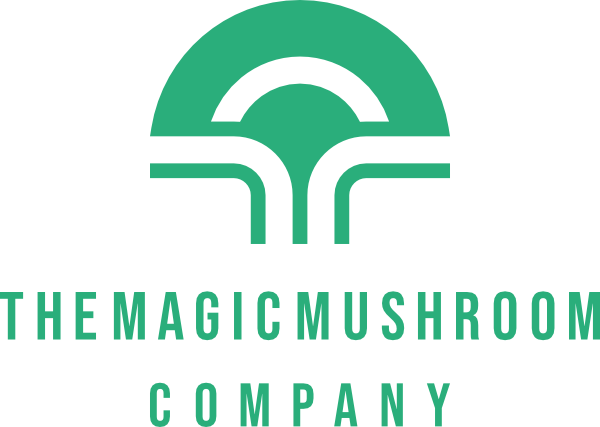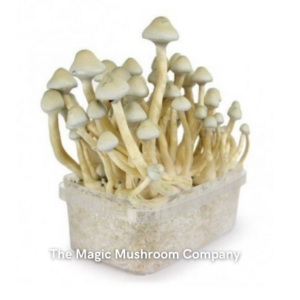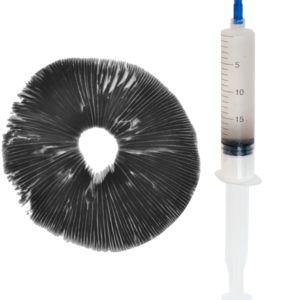Magic Mushroom Spores
What are mushroom spores?
Mushrooms, as with molds, crusts, and truffles, are a type of fungus. Unlike plants, mushrooms do not depend on chlorophyll to sustain themselves. That means instead of munching on light energy, fungi consume food from the substrate they inhabit, such as a felled log or patch of soil. Over a seasonal cycle, mushrooms grow from mycelium and mature so that they can produce spores. But what are spores and why are they important?
Mushroom spores are comparable to plant seeds. These little microscopic cells are how mushrooms propagate and spread from one area to another. Each spore has the basic ingredients, known as hyphae, that, under the right conditions, mature into mycelium.
Spores contain the basic elements to create new fungus. Mature mushrooms, also known as fruiting bodies, release millions of spores before the end of their life cycle. Psilocybin cubensis mushrooms release spores from delicate gills located under their caps. Other mushroom types, like the puffball, will house their spores inside a sac, sort of how you would fill a balloon with water. When the outer structure breaks down, the spores release into the air.
When you buy mushroom spores, you’re getting thousands if not millions of tiny fungus-propagating seeds. Quality spores produce healthier mycelium than poorly harvested spores.
Is it illegal to buy psilocybin spores?
No, it is not illegal to buy psilocybin spores. Unlike magic mushrooms, which are illegal to buy, the spores of the mushrooms contain no psilocybin. It is this specific compound that is illegal across the United States for recreational use. We sell magic mushroom spores solely for research purposes.
In the last few years, psilocybin research has flourished. People buy mushroom spores to better learn how to identify specific mushroom varieties or to collect them into a catalog.
When do spores become illegal?
If you buy fungi spores intending to inoculate substrate to grow magic mushrooms, then the spores become illegal. Your local authority would have to prove that you had this intent, so please be clear about your reasons for buying spores. We do not sell our psilocybin cubensis prints and syringes to grow magic mushrooms; our customers buy our products for general knowledge, microscopy, and other scientific pursuits.
How to harvest mushroom spores?
The easiest and most common mushroom harvesting technique is a spore print. Gilled mushrooms work the best because their spores fall under the cap and thus offer natural protection from dust and debris in your environment. To make a spore print, you’ll need a few common kitchen items:
- 1x mature mushroom cap with exposed gills
- 1x white paper or piece of aluminum foil
- 1x wide-mouthed drinking glass
We suggest aluminum foil because, once you’re finished collecting spores, it’s easier to fold over the print. You know, for later research. To begin, place the cap gill-side down on the tinfoil. Flip the drinking glass over on top of the mushroom cap. This protects the mushroom from being disturbed. Leave the set up for at least twelve hours and up to twenty-four.
When you lift the cap away, you’ll find a detailed spore print. That black thumbprint-like design houses millions of spores. You can scrape away spores and place them under a microscope. To save the print for later, simply fold the tinfoil over, crimp the sides, and stick it in the freezer.
What are some spore collection techniques?
There are a few ways to collect spores from mature mushrooms. Hobbyists, farmers, and mycologists collect spores for easier identification, storing healthy strains for production purposes, or microscopy. The most popular method is the spore print, which we detailed above.
You can also create a spore swab. This method is ideal when working with small mushrooms or when you need spores right away. To harvest spores with a swab, you take a sterilized cotton swab, wet it in distilled water, and brush it against the gills or area that produces spores.
Growing shrooms
No matter how you grow shrooms, you must begin with one crucial element: mushroom spores. With a single spore print or syringe, you can grow hundreds of shrooms over long periods. Spores last for upwards of three years in a chilled environment, such as a fridge. That means one spore purchase should last you two or three grows! But spores aren’t isn’t all you’ll need. Below, we’ll cover the whole shroom-growing process, from materials to harvest.
What You’ll Need
Aside from a spore syringe, you’ll need a few basic materials. Some of it you may have at home, and the rest can be purchased from a local grocer or hardware store. If you start to feel overwhelmed at any time during this explanation, don’t forget we also sell mushroom grow kits. These easy to use kits are a perfect option for first-time growers or budding mycologists.
To grow shrooms, you’ll need canning jars, a 40-quart transparent plastic container, a canning pot or heavy-duty pressure cooker, perlite, vermiculite, and brown rice flour. You’ll also need some mixing bowls, baking measurement cups, and lots of distilled water.
Baking Substrate Cakes
Unlike plants, fungi consume the energy in the soil to expand and produce mushrooms. That means you need to make a nutrient-rich cake that the mycelium, or mushroom fungi, can eat. To do this, mix approximately three parts brown rice flour with one part vermiculite. Then, slowly add water until you create a soft, pillowy substrate. Aim for the viscosity of bread dough. Over-watered substrate won’t work; it tends to get moldy.
Next, you want to “cook” the substrate. You do this by adding the mix into canning jars, sealing them with canning lids, and pressure cooking the jars for at least thirty minutes. Alternatively, you can place the jars in a large canning pot and boil them for two or three hours.
Introducing the Spores
Let the newly sterilized substrate jars cool to room temperature. Once you can safely handle them, punch a few holes in the lid with a sterilized nail. You’ll use these holes to insert your spore syringe and inject a milliliter of the liquid per hole. Store the jars in a dark, dry place. Within one to two weeks, you’ll start to see a white, spiderweb-like material on the inside of the jar. This is mycelium.
Watch the Mycelium Grow!
Over the next few weeks, you should see the mycelium spread across the entire substrate. If you see green or black mold instead of white fungi, your jars have gone bad. Botched jars result from contaminants in the substrate, either by not cooking them long enough or a dirty needle.
After the mycelium has covered the entire substrate, wait another few days for the fungus to fully take hold. In the meantime, you can set up your fruiting chamber.
Enter the Fruiting Chamber
Remember that 40-quart plastic tub? Clean it thoroughly with soapy water, then add about a bag’s worth of wet perlite to the bottom. Perlite will keep the chamber somewhat moist but fend off any mold.
Remove the fungi cakes from the jars and place them in the fruiting chamber. Give the cakes a few hours of light and spray them three times a day with sterilized water to keep them moist. Within another week or two, you should see pinheads, or the beginnings of fruiting bodies, also known as mushrooms.
A single substrate cake can produce shrooms, also known as flushes, two to five times. Each flush will be less robust than the one before it. Fresh mushrooms can rot in a week or less, so if you cannot consume them all, place them on paper towels and let them dry out on a flat surface, such as your kitchen counter. Dried mushrooms can keep for years and can be added to meals or rehydrated in a tea.
Magic Mushroom Spores FAQs
Purchasing magic mushroom spores online is entirely legal. The federal government has no laws against the sale or shipping of mushroom spores because they contain no psychoactive compounds. There is no psilocybin in P. Cubensis spores and having them in your possession presents no risk to you from local or federal authorities. Cultivating magic mushrooms using spores purchased online, however, is illegal.
No. We only sell cubensis mushrooms. They are the easiest to cultivate for spore purposes. Also, mushroom kits using other varieties are very difficult to ship reliably as they often get moldy.
There are some tremendous resources online for psilocybe mushrooms. We recommend Psilopedia. They offer an extensive resource on psilocybin studies, pharmacology, legal history, and growing tutorials. Their forum remains one of the best ways to connect with other magic mushroom advocates around the world.
The time from inoculation to fresh fruits depends greatly on your substrate medium and controlled environment. For example, using a jarred substrate and a spore syringe, you can expect mushrooms in two to four weeks. The temperature of your home, moisture levels, light source, and spore genetics all play a vital role in the final time.
Agar culture and 3T bags require more time, but the yields on bags is much higher. Agar culture takes three weeks to colonize in a bag, and then another week or more once shredded and mixed into your growing medium.
Our mushroom grow kits speed up the process. Because we’ve already inoculated your substrate and provided you with a moisture tent, you can expect your first flush in as little as two weeks.
A spore print stored in a dry and safe place is good for up to ten years. Spore syringes should be used within a year, but some customers report re-using a syringe as long as two years after purchase. We recommend buying new spore syringes after around eight months because the effort to make substrate cakes requires a solid few hours effort.
Some mycologists suggest that more spore liquid speeds up the growing process. In our experience, this seems to be true. So you’ll want to inoculate each jar with at least 5ml of the solution. That means a single syringe can inoculate two pint-sized jars. If you plan to use agar culture, don’t use a spore syringe with jars. Agar is grown in a petri dish, and each dish requires about 5ml of solution.
Jars are the go-to method for beginners because they are less prone to contamination and are a third of the start-up costs. With substrate cakes in jars, you also get magic mushrooms fast, sometimes in as little as two weeks.
To grow cubensis mushrooms in bags, you must start with agar culture. You’ll need petri dishes and special sterilization processes to successfully inoculate agar culture. When amateur mycologists talk about bags, they are mostly referring to bulk cultivation. You can grow a lot more mushrooms with bags, but the trade-off is that you need an industrial air filter, known as a flow hood, to inhibit contamination.
(still don’t have an answer to this, working on it)
Our spore syringes are made in a fully-sterilized workroom with air filtration. Unlike many psilocybe cubensis syringes for sale online, ours contain thousands of spores. A single spore is naked to the human eye. "Invisible spores" are the excuse many brands use to convince customers to buy products with very few spores in them.
We believe that the more spores in the syringe, the better your chances of a successful experience. That’s why our products contain visible clumps of thousands or millions of P. cubensis spores.
A quality magic mushroom spore syringe can last for months or years after purchase, so don’t waste your money on a cheap product with too few spores. We also offer a 30-day money-back guarantee. You can return any syringe that does not meet your expectations for a full refund, no questions asked.



